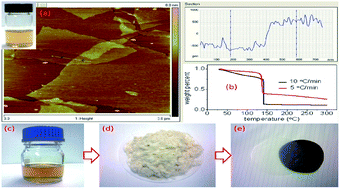A graphene oxide–polyvinylidene fluoride mixture as a precursor for fabricating thermally reduced graphene oxide–polyvinylidene fluoride composites
Abstract
A solid mixture of graphene oxide (GO) with polyvinylidene fluoride (PVDF) was investigated as the precursor material for fabricating graphene–PVDF nanocomposites. The mixture was prepared by solution mixing GO in PVDF solution followed by coagulation. Hot-pressing of the mixture led to the reduction of GO to graphene, and transformed the material to a graphene–PVDF nanocomposite. Consequently, the in situ thermally reduced graphene (TRG) sheets were found to be dispersed homogeneously in the polymer matrix. This resulted in a very low percolation threshold of 0.12 vol% TRG. In addition, hot-pressed GO–PVDF mixtures with higher filler loadings were employed as the master batches for forming conductive polymer composites by melt compounding. This processing route has great potential for scalable production of electrically conductive graphene–polymer nanocomposites.


 Please wait while we load your content...
Please wait while we load your content...